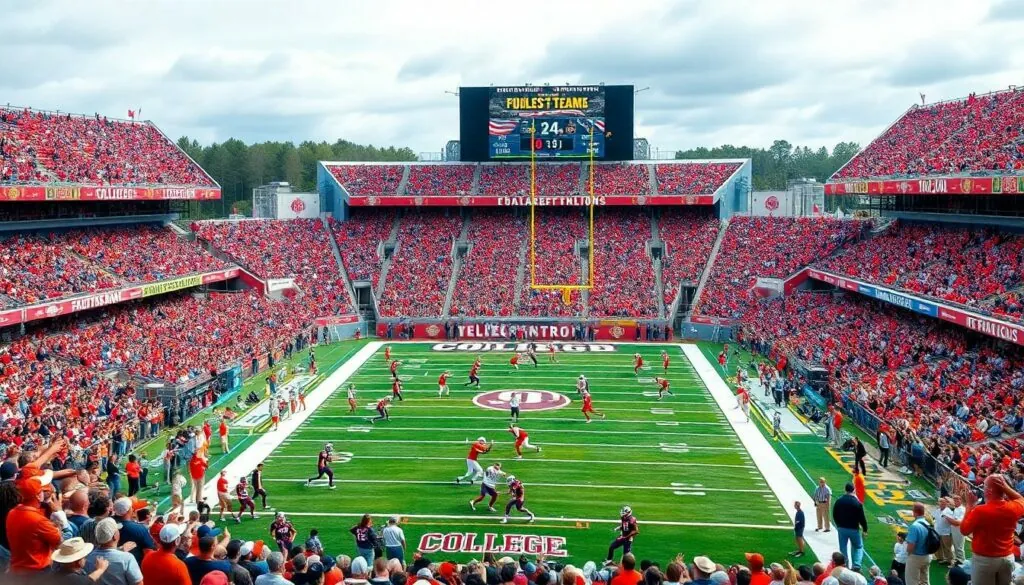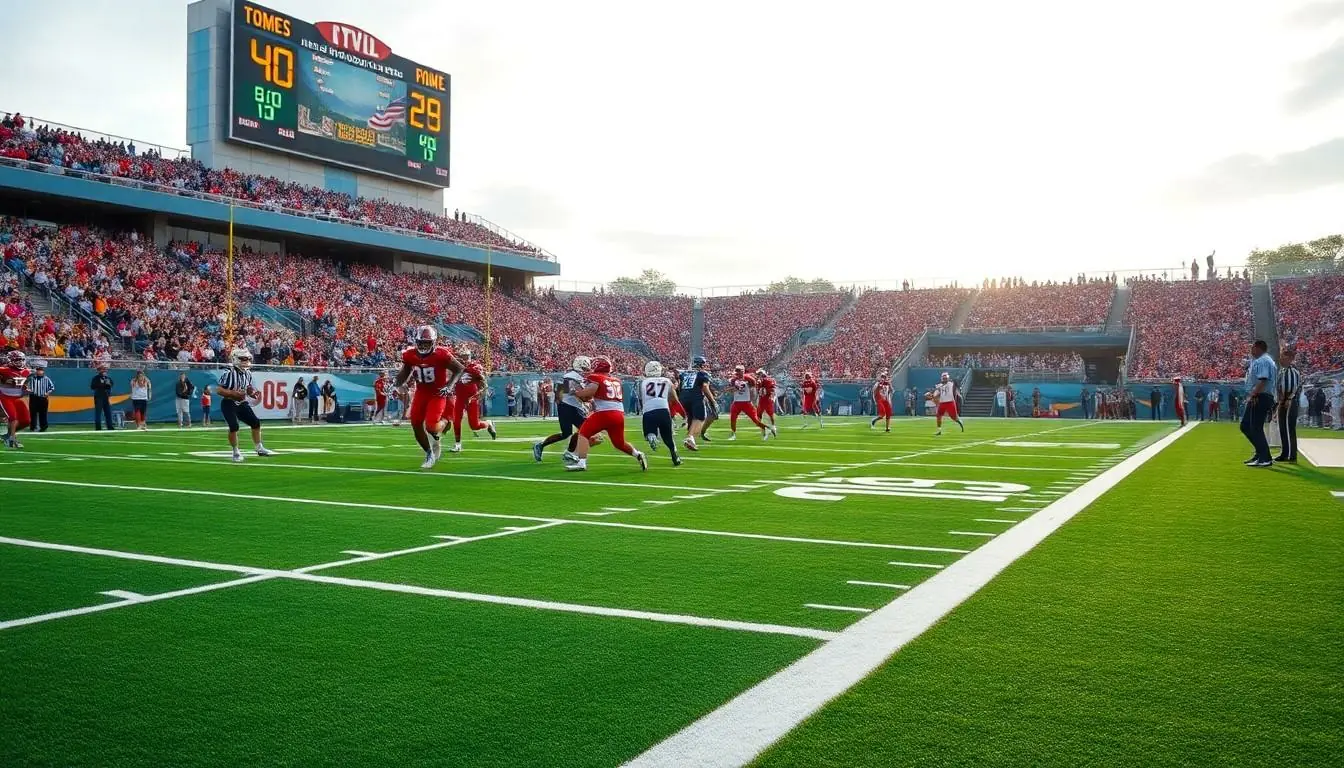Table of Contents
ToggleWhen it comes to college football, time is more than just a ticking clock; it’s a game of strategy, excitement, and sometimes, a little confusion. Fans often wonder how many minutes are in a college football quarter, and the answer might surprise them. Spoiler alert: it’s not as long as your favorite Netflix binge, but it sure feels like an eternity when your team is down by a touchdown.
Overview of College Football Quarters
In college football, each quarter lasts 15 minutes. These 15-minute segments dictate the pacing of the entire game. Four quarters constitute a full game, totaling 60 minutes of playtime. The clock stops for various reasons, including timeouts and penalties, which can extend the duration of each quarter significantly.
Fans often experience the thrill of watching plays unfold during these quarters. Strategies become apparent as teams adapt their game plans based on the situation at hand. Tight games can lead to intense moments, particularly in the latter stages of a quarter. Many fans find that the emotional weight of a close matchup can make these minutes feel much longer than they actually are.
Despite the official timer, instances such as injuries and stoppages can affect the flow of play. Teams utilize this time to regroup and assess their strategies, showcasing football’s strategic nature. Each quarter’s end brings a brief intermission, allowing coaches to communicate vital adjustments.
Understanding the structure of these quarters enhances the viewing experience. Key plays often define the outcomes in critical moments at the end of each quarter. This creates a compelling atmosphere that keeps fans on the edge of their seats. The unique rhythm of college football—marked by its quarters—sets it apart from other sports, making each game a captivating experience.
Duration of College Football Quarters
Each college football quarter lasts 15 minutes. Game dynamics influence perceptions of time, making these minutes feel longer, particularly in intense situations.
Standard Quarter Length
A standard college football quarter measures 15 minutes in gameplay. Each game features four quarters, totaling 60 minutes of regulation play. The clock, however, doesn’t run continuously. Stoppages for timeouts, penalties, or injuries often extend the time, allowing strategy adjustments. For instance, if a team faces a timeout, the game clock halts, giving coaches a chance to devise new tactics. These intervals can stretch the quarter beyond the typical duration, engaging fans further as the action unfolds.
Comparison to Other Levels of Play
College football quarters compare interestingly to NFL quarters, which last 15 minutes as well. Different levels, including high school football, use shorter quarters, typically 12 minutes. Variations in quarter length create distinct pacing and strategic approaches across leagues. The NCAA rules also allow for unique timing regulations, such as stop-clock rules during the last two minutes of each half. This difference enhances the excitement and strategy involved in college games, setting it apart from other football formats.
Game Structure and Time Management
Understanding the game structure enhances the appreciation of college football. Each quarter spans 15 minutes, but various factors influence this timing, including halftime and overtime rules.
Halftime and Overtime Rules
Halftime occurs between the second and third quarters, lasting 20 minutes. This break allows teams to regroup and strategize for the second half. In addition, overtime rules come into play if the score is tied at the end of regulation. Each team receives one possession in overtime, starting from the opponent’s 25-yard line. If the game remains tied after two possessions, additional overtime periods occur. These rules make strategies crucial as teams aim for victory during these high-pressure moments.
The Role of Timeouts
Teams obtain three timeouts per half, with each lasting 60 seconds. Coaches utilize these timeouts strategically to halt play for adjustments or to stop the clock. Effective use of timeouts can shift the momentum of a game, especially in critical situations. Additionally, each team can call a timeout to prevent a delay of game penalty. Managing timeouts effectively becomes essential for achieving objectives and maximizing scoring opportunities.
Impact of Quarter Length on Gameplay
Quarter length significantly influences gameplay strategies in college football. Each quarter lasts 15 minutes, but the actual time spent can extend due to stoppages for timeouts and penalties. Coaches must adapt their strategies based on this rhythm, often using timeouts to make critical adjustments or to halt the clock during pivotal moments.
Strategies shift dramatically as the game progresses. Close matchups particularly amplify the emotional stakes, making the last moments of a quarter crucial. Players and coaches feel increased pressure, heightening the excitement for fans. Furthermore, injuries and other stoppages disrupt momentum, allowing teams to regroup and reassess their tactics.
End-of-quarter situations often lead to unique scenarios. Coaches use these brief intermissions to convey necessary adjustments, which can change the game’s dynamics. As the quarter concludes, anticipation builds, especially when teams find themselves in tight contests where every second counts.
Comparison of college football quarters to NFL quarters reveals similar structures, but college play features distinct timing rules that can enhance drama. Unique NCAA regulations allow the clock to stop in specific situations during the final two minutes of each half, creating additional strategic layers. Each moment is critical, and teams must navigate these timing nuances effectively to maximize scoring opportunities.
The overall game structure, including halftime and overtime scenarios, further impacts gameplay. Teams receive a 20-minute halftime break to recalibrate for the second half, while overtime rules introduce fresh strategies, starting each team’s possession at the opponent’s 25-yard line. Effective management of timeouts, with each team allotted three per half, remains essential for seizing control and ensuring optimal performance throughout the game.
Conclusion
Understanding the structure of college football quarters is crucial for fans and players alike. Each quarter lasts 15 minutes but the actual gameplay often extends due to various stoppages. This dynamic adds layers of strategy and excitement to the game as teams navigate timeouts and adjust their tactics.
The unique pacing and timing regulations in college football create an engaging atmosphere that enhances the overall experience. As fans witness critical moments unfold in each quarter, the emotional stakes rise, making every second count. The interplay of time management and strategy ultimately shapes the outcome of games, ensuring that college football remains a thrilling spectacle.








